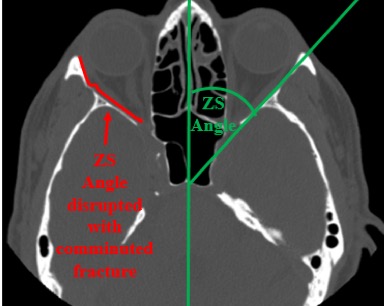Defining the zygomaticosphenoidal angle as a guide to anatomic zygomaticomaxillary complex fracture reduction
Avinoam Levin, BA, Brandon De Ruiter, BS, David Nash, MD, George Kamel, MD, Evan Mostafa, BS, Daniel Baghdasarian, BS, Edward H. Davidson, MD.
Montefiore Medical Center/Albert Einstein College of Medicine, New York, NY, USA.
Background:
Alignment of the zygomaticosphenoid (ZS) suture is fundamental to reduction of zygomaticomaxillary complex (ZMC) fractures. Lateral displacement and anteroposterior impaction of the anterior segment must be corrected. Furthermore, to prevent a rotational deformity, the correct angle of the zygoma relative to the cranial base must be restored. Clinically this can be a challenge, especially when there is comminution of the ZS suture. Defining a zygomaticosphenoidal angle would provide a reference guide for use in conjunction with stereotactic navigation to achieve anatomic orientation of the anterior fracture segment. Normative data of this angle could be used in bilateral fractures and, if constant across laterality, patient-specific data could be used as a guide in unilateral injuries.
Methods:
A retrospective chart review of 100 patients was designed to determine normative values of the ZS angle of craniomaxillofacial trauma patients. Computed tomography (CT) data of patients with isolated nasal or mandible fractures was used. An angle subtended by the midline and a best fit line through the ZS on axial view was measured bilaterally. The mean value of this measurement for three vertically adjacent 0.625mm cuts was calculated with the position of central cut determined by the equator of the globe and trigone of the sphenoid. Measurements and assessment of cuts to be measured were performed by 2 investigators. Where there was a discrepancy, analysis was repeated with collaboration to ensure consensus. Demographic data including age, sex, and ethnicity was also collected for comparison.
Results:
Mean ZS angle was 47o (range 38o -56o). 90% angles were within two standard deviations (8o) of the mean. Subgroup analysis demonstrated no significant difference of ZS angle across age, sex or ethnicity. For each angle the variation across the 3 sample cuts was ≤4.5o in all cases. Patients demonstrated high fidelity of ZS angle bilaterally with 97% demonstrating <6o variation.
Conclusion:
The zygomaticosphenoidal angle is a potentially useful reference guide, for use in conjunction with stereotactic navigation, to achieve anatomic reduction of ZMC fractures. 
Back to 2018 Abstracts




